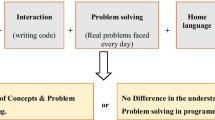Abstract
A large number of introductory programming environments for K-12 education have become widely used across the world. One of the main ideas behind these environments is introducing basic programming concepts more effectively by incorporating different visualization strategies. There have been attempts to classify introductory programming tools, however, certain critical aspects have not yet been discussed within the existing classifications, especially those related to user engagement in the programming environment. In this paper we introduce an engagement taxonomy for introductory programming tools (ETIP) built on a concept of engagement taxonomy for software visualization and previous classifications of programming learning tools. The new taxonomy is then used to inclusively review introductory programming environments for secondary education used today with a focus on user engagement in a learning environment. Our review illustrates how majority of introductory programming tools do not fully explore the ways visualizations could help with tackling the problems of beginner programming comprehension. There is still a lack of knowledge about the importance of the level of engagement in visual introductory programming tools and the suggested taxonomy could be used for future research of computer science education.
Access this chapter
Tax calculation will be finalised at checkout
Purchases are for personal use only
Similar content being viewed by others
References
Brown, N.C., Altadmri, A.: Investigating novice programming mistakes: educator beliefs vs. student data. In: Proceedings of the Tenth Annual Conference on International Computing Education Research, pp. 43–50, July 2014
Duncan, C., Bell, T., Tanimoto, S.: Should your 8-year-old learn coding? In: Proceedings of the 9th Workshop in Primary and Secondary Computing Education, pp. 60–69, November 2014
Grover, S., Basu, S.: Measuring student learning in introductory block-based programming: examining misconceptions of loops, variables, and boolean logic. In: Proceedings of the 2017 ACM SIGCSE Technical Symposium on Computer Science Education, pp. 267–272, March 2017
Hidalgo-Céspedes, J., Marín-Raventós, G., Lara-Villagrán, V.: Learning principles in program visualizations: a systematic literature review. In: 2016 IEEE Frontiers in Education Conference (FIE), pp. 1–9. IEEE, October 2016
Hundhausen, C.D., Douglas, S.A., Stasko, J.T.: A meta-study of algorithm visualization effectiveness. J. Vis. Lang. Comput. 13(3), 259–290 (2002)
João, P., Nuno, D., Fábio, S.F., Ana, P.: A cross-analysis of block-based and visual programming apps with computer science student-teachers. Educ. Sci. 9(3), 181 (2019)
Karavirta, V., Shaffer, C.A.: JSAV: the JavaScript algorithm visualization library. In: Proceedings of the 18th ACM Conference on Innovation and Technology in Computer Science Education, pp. 159–164. July 2013
Kelleher, C., Pausch, R.: Lowering the barriers to programming: a taxonomy of programming environments and languages for novice programmers. ACM Comput. Surv. (CSUR) 37(2), 83–137 (2005)
Lister, R., et al.: A multi-national study of reading and tracing skills in novice programmers. ACM SIGCSE Bull. 36(4), 119–150 (2004)
Luxton-Reilly, A., et al.: Introductory programming: a systematic literature review. In: Proceedings Companion of the 23rd Annual ACM Conference on Innovation and Technology in Computer Science Education, pp. 55–106, July 2018
Mladenović, M., Boljat, I., Žanko, Ž.: Comparing loops misconceptions in block-based and text-based programming languages at the K-12 level. Educ. Inf. Technol. 23(4), 1483–1500 (2017). https://doi.org/10.1007/s10639-017-9673-3
Myller, N., Bednarik, R., Sutinen, E., Ben-Ari, M.: Extending the engagement taxonomy: software visualization and collaborative learning. ACM Trans. Comput. Educ. (TOCE) 9(1), 1–27 (2009)
Naps, T.L., et al.: Exploring the role of visualization and engagement in computer science education. In: Working Group Reports from ITiCSE on Innovation and Technology in computer Science Education, pp. 131–152 (2002)
Papert, S.: Mindstorms: Computers, children, and Powerful Ideas, p. 255. Basic Books, New York (1980)
Qian, Y., Lehman, J.: Students’ misconceptions and other difficulties in introductory programming: a literature review. ACM Trans. Comput. Educ. (TOCE) 18(1), 1–24 (2017)
Rijke, W.J., Bollen, L., Eysink, T.H., Tolboom, J.L.: Computational thinking in primary school: an examination of abstraction and decom-position in different age groups. Inf. Educ. 17(1), 77 (2018)
Saito, D., Sasaki, A., Washizaki, H., Fukazawa, Y., Muto, Y.: Program learning for beginners: survey and taxonomy of programming learning tools. In: 2017 IEEE 9th International Conference on Engineering Education (ICEED), pp. 137–142. IEEE, November 2017
Simon. Assignment and sequence: why some students can’t recognise a simple swap. In: Proceedings of the 11th Koli Calling International Conference on Computing Education Research (Koli Calling 2011). Association for Computing Machinery, New York, NY, USA, pp. 10–15 (2011). https://doi.org/10.1145/2094131.2094134
Sorva, J., Karavirta, V., Malmi, L.: A review of generic program visualization systems for introductory programming education. ACM Trans. Comput. Educ. (TOCE) 13(4), 1–64 (2013)
Thomas, L., Ratcliffe, M., Thomasson, B.: Scaffolding with object diagrams in first year programming classes: some unexpected results. ACM SIGCSE Bull. 36(1), 250–254 (2004)
Urquiza-Fuentes, J., Velázquez-Iturbide, J.Á.: A survey of successful evaluations of program visualization and algorithm animation systems. ACM Trans. Comput. Educ. (TOCE) 9(2), 1–21 (2009)
Vieira, E.A.O., Da Silveira, A.C., Martins, R.X.: Heuristic evaluation on usability of educational games: a systematic review. Inf. Educ. 18(2), 427–442 (2019)
Weintrop, D., Wilensky, U.: Transitioning from introductory block-based and text-based environments to professional programming languages in high school computer science classrooms. Comput. Educ. 142, 103646 (2019)
Xu, Z., Ritzhaupt, A.D., Tian, F., Umapathy, K.: Block-based versus text-based programming environments on novice student learning outcomes: a meta-analysis study. Comput. Sci. Educ. 29(2–3), 177–204 (2019)
Author information
Authors and Affiliations
Corresponding author
Editor information
Editors and Affiliations
Appendices
Appendix 1
General information of introductory programming environments for K-12 sorted by the age of target audience.



Appendix 2
Classification of introductory programming tools for K-12 education.


Rights and permissions
Copyright information
© 2020 Springer Nature Switzerland AG
About this paper
Cite this paper
Šiaulys, T. (2020). Engagement Taxonomy for Introductory Programming Tools: Failing to Tackle the Problems of Comprehension. In: Kori, K., Laanpere, M. (eds) Informatics in Schools. Engaging Learners in Computational Thinking. ISSEP 2020. Lecture Notes in Computer Science(), vol 12518. Springer, Cham. https://doi.org/10.1007/978-3-030-63212-0_8
Download citation
DOI: https://doi.org/10.1007/978-3-030-63212-0_8
Published:
Publisher Name: Springer, Cham
Print ISBN: 978-3-030-63211-3
Online ISBN: 978-3-030-63212-0
eBook Packages: Computer ScienceComputer Science (R0)




